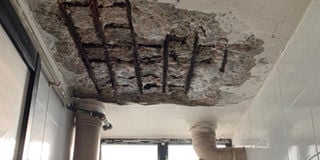When concrete ceilings fall in

Some concrete ceilings fall in because poor material was used in construction. PHOTO/net
What you need to know:
The argument is that these slab ceilings absorb heat and do not easily get damaged like those made out of plywood, glass and wood
Slab concrete is a preferred ceiling solution for many people constructing homes. The argument is that these slab ceilings absorb heat and do not easily get damaged like those made out of plywood, glass and wood.
However, concrete ceilings occasionally have their woes, especially when they cave in.
Using poor materials
Jamil Kayemba, an engineer says, using low quality building materials is one of the reasons why ceilings break within a short period of time.
“You have to ensure that the building materials you are using are strong enough to hold all that mass especially when it is still wet, because that is when it is heavier,” he says.
He adds, “this can start with small cracks, though, after some time they become large and if not attended to can result into an accident.”
Physical movement in the building
Kayemba says, any physical movement in the building can break your ceiling and this can be due to seasonal temperature changes, for instance, home foundation can move or expand as temperatures rise or fall.
“Physical movement in materials that are attached to the structure, including the plaster board on ceiling can make it to collapse which is very costly to repair,” he says.
Kayemba says that it is better to buy genuine materials and hire experts with experience in building such ceilings.
Roof leaks
In cases where the roof is leaky, chances of the water leaks damaging the concrete ceiling are high. Simple leakages can worsen and while many are not watching, the ceiling plaster board has become too heavy.
“Waterlogged insulation is incredibly heavy and when it falls, it can cause serious damage and in some cases, serious injury to family members,” he says.
He adds that if you spot a slow-growing patch of molds or stains on your ceiling, they are signs of a leak that needs immediate attention.
Vibrations from electric doors and windows
Kayemba says, when your door vibrates while opening or closing, the power that operates the doors may damage the ceiling.
“If these vibrations are repeated often, the continued stress can cause your ceiling to crack.”
Remedy
It usually occurs in older buildings and is particularly problematic in bathrooms, as moisture causes the steel parts to rust. Experts have said spalling concrete poses no risks to structural integrity unless it is neglected, allowing it to spread.
There is not a known way one can prevent ceilings from falling besides ensuring the builders carry out their jobs diligently.
However, even when they do so, there are chances that after very many years, older houses naturally weaken and ceilings may develop cracks that may later break if they are not taken care of.
It is advisable that home owners do regular checks and repairs on their houses to keep them in good shape and condition.




